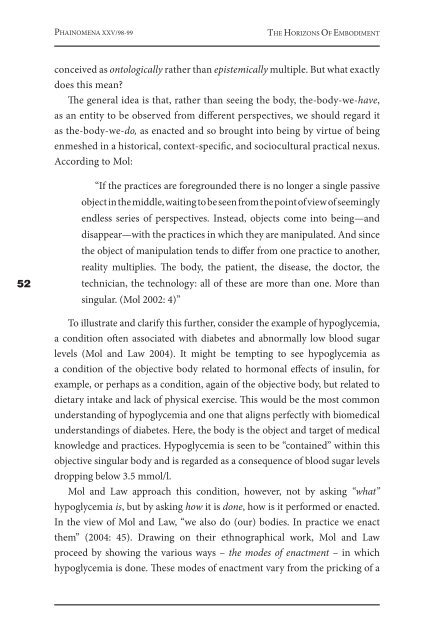phainomena
PHAINOMENA-98-99_e-verzija
PHAINOMENA-98-99_e-verzija
You also want an ePaper? Increase the reach of your titles
YUMPU automatically turns print PDFs into web optimized ePapers that Google loves.
PHAINOMENA XXV/98-99<br />
THE HORIZONS OF EMBODIMENT<br />
conceived as ontologically rather than epistemically multiple. But what exactly<br />
does this mean?<br />
The general idea is that, rather than seeing the body, the-body-we-have,<br />
as an entity to be observed from different perspectives, we should regard it<br />
as the-body-we-do, as enacted and so brought into being by virtue of being<br />
enmeshed in a historical, context-specific, and sociocultural practical nexus.<br />
According to Mol:<br />
52<br />
“If the practices are foregrounded there is no longer a single passive<br />
object in the middle, waiting to be seen from the point of view of seemingly<br />
endless series of perspectives. Instead, objects come into being—and<br />
disappear—with the practices in which they are manipulated. And since<br />
the object of manipulation tends to differ from one practice to another,<br />
reality multiplies. The body, the patient, the disease, the doctor, the<br />
technician, the technology: all of these are more than one. More than<br />
singular. (Mol 2002: 4)”<br />
To illustrate and clarify this further, consider the example of hypoglycemia,<br />
a condition often associated with diabetes and abnormally low blood sugar<br />
levels (Mol and Law 2004). It might be tempting to see hypoglycemia as<br />
a condition of the objective body related to hormonal effects of insulin, for<br />
example, or perhaps as a condition, again of the objective body, but related to<br />
dietary intake and lack of physical exercise. This would be the most common<br />
understanding of hypoglycemia and one that aligns perfectly with biomedical<br />
understandings of diabetes. Here, the body is the object and target of medical<br />
knowledge and practices. Hypoglycemia is seen to be “contained” within this<br />
objective singular body and is regarded as a consequence of blood sugar levels<br />
dropping below 3.5 mmol/l.<br />
Mol and Law approach this condition, however, not by asking “what”<br />
hypoglycemia is, but by asking how it is done, how is it performed or enacted.<br />
In the view of Mol and Law, “we also do (our) bodies. In practice we enact<br />
them” (2004: 45). Drawing on their ethnographical work, Mol and Law<br />
proceed by showing the various ways – the modes of enactment – in which<br />
hypoglycemia is done. These modes of enactment vary from the pricking of a


